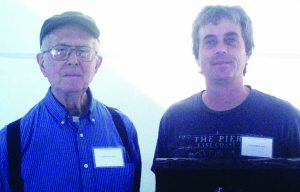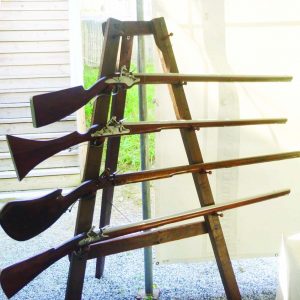by James Fulmer | Past President, NMLRA

Leonard Day Jr., left, and his son John Day.
The 35th Annual Dixon’s Gunmakers’ Fair has come and gone for another year. Located near Kempton, PA, it is one of the largest gatherings of people interested in building muzzleloaders and powder horns in the country. Muzzleloader gun builders from all over the country will come and share their ideas and their craft to each other and the public. Thirty-five years is a long time for any event to run every year. But this event has evolved so much from its inception by growing with ever expanding knowledge passed from generation to generation by craftsmen.
When you think of a traditional muzzleloader you think of flintlock long rifle, or maybe the half stock shorter “Hawken” style rifle, or the muzzleloaders from the Civil War. Very few people think about the muzzleloaders that were used in this country before our war for Independence 1776. At Dixon’s Annual Gunmaker’s Fair you will see mostly the 1750-1820 flintlock style long rifle. There are so many gun builders of both historical and contemporary long rifles you would be in awe of the craftsmanship of these custom builders.
While there are many men who stand out in their field, only one man who stands out for his making of both quality reproductions of 17th and 18th century black powder firearms. That is Leonard Day Jr. He is 84 years old now, but he was only 49 years old when the Gunmaker’s Fair got started. He had been making muzzleloaders since 1970 which would be 12 years before the Fair got started.
Leonard Day lives near Westhampton, MA. Many styles of original muzzleloading firearms are found in that area. The two barreled swivel breech muzzleloader is one of those rifle styles. There were many attempts to make multiple shot firearms through history. After the invention of the “flintlock” mechanism a dependable second shot became possible by using a multiple barrel gun. The French were making a turnover gun by the 1620s. A large number of turnover pistols were exported from the Netherlands to England during the English Civil War. The popularity of the option of having that second “quick” shot was a definite advantage, both for hunting and or defense.
Nearly 100 years after its inception in Europe the idea of the second shot would arrive in America with skilled gunsmiths that were a part of the German migration of the 1710-1735 time period. These craftsmen would develop a truly American firearm that would become known as the “Kentucky” Long rifle. Developed in Pennsylvania it was made famous by Kentucky riflemen during the War of 1812. Only a very small percent would make the “swivel breech” but the ones that were made would make history.
American riflemen would make history and would make them famous by using them on many occasions throughout history. Hugh Mercer took out a French officer on the Plains of Abraham during the French & Indian War with his swivel breech. Then there was the famous Tim Murphy who was credited for killing British General Simon Frazier at the Battle of Saratoga in New York state during the American Revolution. The famous Jim Bridger known during the fur trapping era out west owned a percussion swivel breech built by John Shuler of Pennsylvania. There are many famous makers of the swivel breech during the Golden Age of the muzzleloader. Some of the more famous names where D. Boyer, Jacob Kunz, James Grumpf, and John Meals — all gunsmiths during the Golden Age of muzzle-loading.
The first Leonard Day Swivel Breech was produced in 1971. The action he made for the swivel breech was in response to a challenge, could anybody make a good swivel breech muzzleloader? Leonard gave it a try and succeeded and his rifle would be featured in the December issue in 1983 of Guns & Ammo. The following spring a mailing was sent out to the owners of the swivel breeches he had produced the first dozen years asking how they felt about the “Day” swivel breech inviting comments, or suggestions. The response on the postal card was really gratifying with glowing comments that Leonard’s mail carrier was that impressed he ordered one of his swivel breech rifles for himself!

Many historical muzzle-loaders of Leonard Day Jr.
The Leonard Day swivel breech comes in two models the “Day First Model Swivel Breech” which is a reproduction of a swivel breech of the 1780-1825 period. This is a double 13/16 barrels straight octagonal 32” long. It comes in .32 cal. to .50 cal., rifled or smooth. The other model swivel rifle is called the “Day” Pre-Hawken Style Swivel Breech, which is a reproduction of an iron mounted rifle used from 1810 on. The double barrels are 15/16” tapered on six flats to 7/8” X 32” long — your choice of caliber up to .58 cal, — smooth bore or rifled. The swivel breech system on these rifles was developed by Leonard Day and all the parts that are cast are cast on his molds and are assembled on his fixtures.
Needless to say when he arrived at the Dixon’s Gunmakers’ Fair years ago his rifles where an attraction that muzzleloading enthusiasts would travel literally across the country to see and handle. Over a generation later he has kept people’s interest by reproducing older style muzzleloading firearms of the 1600s. In the picture shown the top firearm shown is a reproduction he makes of a Dutch Trade Gun which is a .62 caliber smoothbore that was of the 1625-1650 time period. The Dutch brought an estimated 100,000 guns of this style to this country before 1680. Originals can be found from Maine to Mississippi. They where trade guns made just for the Dutch fur trade and no examples exist in Europe. The butt style and parts come from Susquehanna River sites and the Rochester Museum and it is an accurate reproduction of this firearm.
The third firearm pictured from the top is an Enoch Bolton who was a gun builder in Charleston, MA. This piece is made for wing shooting and the butt acts like a counter balance. The original is owned by Historic Deerfield and the time period Enoch made his firearms was around 1650-1660.
Leonard Day Jr. at 84 still recreates and reproduces a very special part of our American Firearms history. His continued love of muzzleloading has already spanned generations. Looking forward to seeing him next year at the Gunmakers’ Fair.



